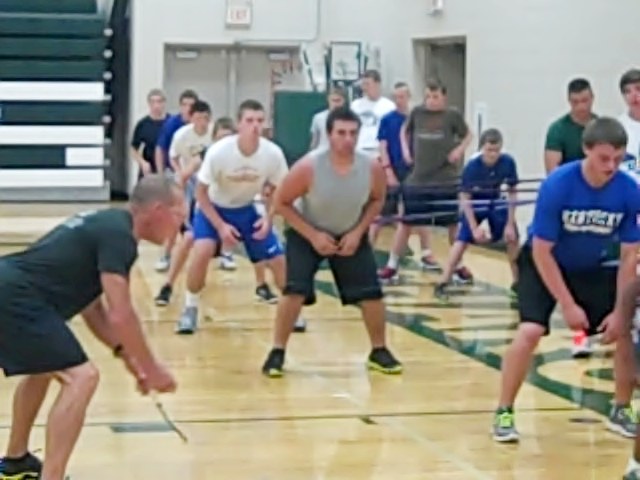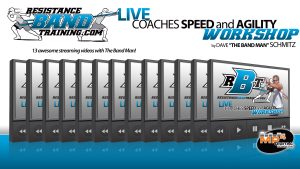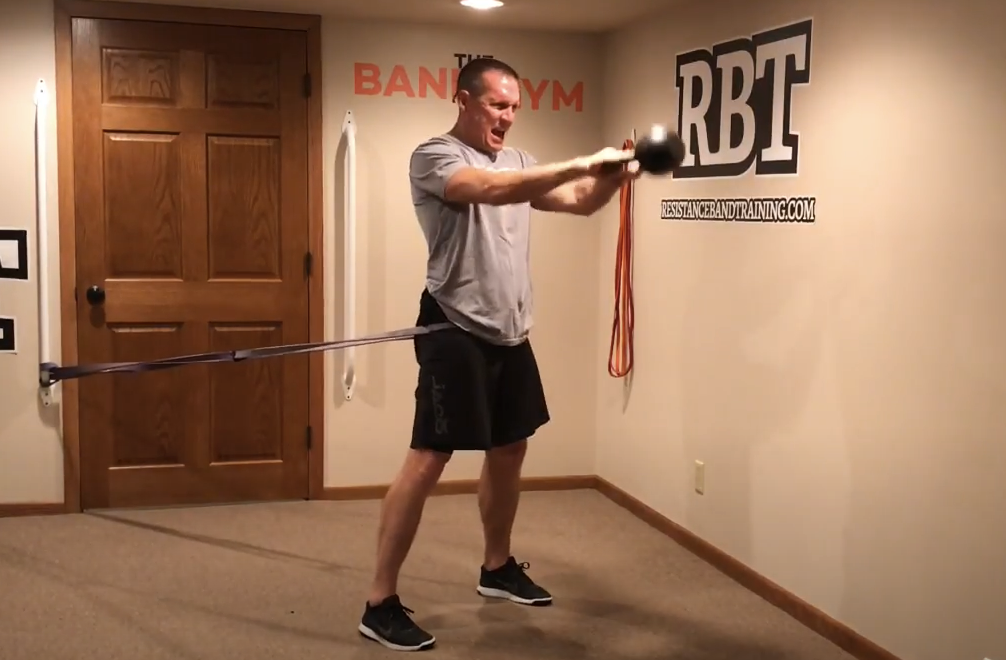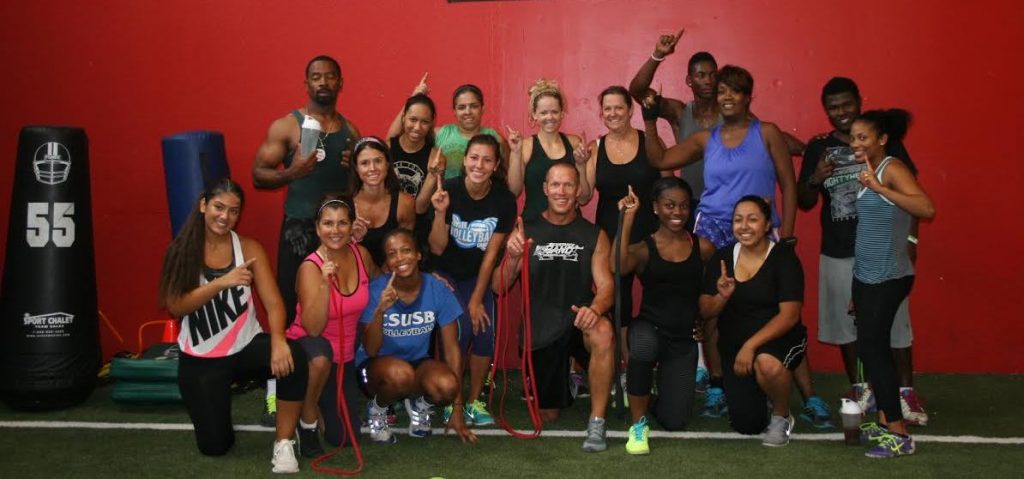Resistance Bands As an Off-Season Strength & Speed Training Tool
Below are ways to use bands in the off-season.
1. Dynamic Strength Training
We design our off-season training into 4 week mini-cycles. Every 4th week is a de-load week or a testing week. During this time, we will add bands into primary exercises like back squats, bench press or dead lifts.
Also, for fun I will teach the athletes a new band–dumbbell or band-barbell auxiliary exercise. Things like barbell-band curls, crossover speed squats or high velocity horizontal pushes.
The goal is to allow the body to recover while having to adapt to a different stimulus. We want effort on primary lifts but not to failure.
If we are testing, obviously that is not the case. Once the athlete starts to understand how to use the bands with barbells, we become a little more frequent at implementing them into the program.
2. Circuit Based Metabolic Training
Every now and then the athletes need a “shocker” which is typically going to be either a competition or a metabolic circuit. Normally, I will set up 1 or 2 types of circuits. Circuit 1 is 50% band stations and 50% dead weight or body weight stations. This creates a great neuromuscular contrast.
Circuit 2 is exclusively resistance bands. Since band resistance is neuro-muscularly such a different type of load, we find doing this typically keeps athletes from plateaus and creates a dramatic change of pace.
A typical metabolic circuit could be:
Split Squat Right – Split Squat Left – Horizontal Pushing – Horizontal Pulling – Push Press – Resisted Plank – Straight Leg Dead lift – Partner Assisted Glut/Ham – Hammer Curl – Tricep Extension High Pull
Using resistance bands to create a circuit is so easy because you just lay out the resistance bands or give each athlete one band and get started. The other thing is we will often do this out of the weight room which creates a nice change of pace.
3. Middle School Strength Program
Another way I bring resistance bands into our off-season program from a strength standpoint is by running a 1 or 2 time per week 8th grade strength camp. This camp usually entails using body weight and bands with maybe some barbell only lifts as they become more advanced.
Resistance bands seem to sell the workout and they teach the kids how to truly lock out on their Squat, Military Press, and Dead Lift. I find 8th graders are eager to get into the high school weight room but typically nothing really fits their body stature.
Therefore, initially training with resistance bands and body weights allows them to get control of their body, especially eccentrically before we have them start to use small bars, PVC pipes or actual olympic bars.
Training this age group early with bands, I find, provides them with the eccentric control and awareness that ultimately makes dead weight training easier.
If they can safely control the accelerated eccentrics of band training, a dead weight becomes much easier to control.
4. First Step Acceleration
It’s a pretty well known fact that if you win the first 5 yards or 3 steps in a game you probably are going to have good success and ultimately win most of the time. These are hands down the drills athletes enjoy the most.
They require a very small amount of space, can be done anywhere there is space, usually only 2 bands with a link strap or 1 thunder band and work well with partner based training.
We keep it simple by focusing on 4 basic drills:
Shuffles – Forward Bursts – Backpedals – Crossover (or Turn and Go)
These drills are typically done in partnerships with athletes performing 3-4 sets of 5 reps. Because these drills focus exclusively on acceleration, I instruct the athletes to return back slowly, set themselves and explode.
Another option for training is for the coach to control everything with a whistle start which is an effective way to initially teach the drills and control the cadence of reps.
5. Agility or Deceleration Training
Your acceleration is only as good as your deceleration control and it takes a lot of strength to slow down fast. Deceleration control also requires significantly better total body integration to keep joints stable and positioned correctly. As a result, the other phase of speed we work on is 2-step deceleration training.
These drills require our athletes to pre-load the band and work on performing 2 fast deceleration steps first, followed immediately by 2 acceleration steps. Without a doubt, resistance bands were made for this drill and performing this in partnerships makes this drill an easy drill to do anywhere.
Like with acceleration drills our athletes perform both of these 2-step drills using a shuffle, forward burst, backpedal and crossover.
6. Linear Speed Training
Even though we feel very strongly about first step explosiveness, athletes need to be able to accelerate out 15 to 20 yards as well. This is where partner resisted running comes into play. Again using the partner based set-up, athletes alternate reps while performing linear resisted runs of 10 to 20 yards.
These are typically done using a hip attachment initially but will eventually move into a harness set up to integrate the trunk and hip.
To learn more about using bands for speed, Accelerating to the Ball is your best option.
7. Sport Specific Training
As our athletes master many of the basic drills we have discussed, it is always fun for the athlete to work on sport specific movements that they perform every day in their sport of choice.
For example…
- Lineman fire-outs
- Lineman swim moves
- Basketball posting
- Baseball fielding
- Block starts
- Soccer kicks
There are tons of sport specific drills that can be implemented with resistance bands. Honestly, your imagination and understanding of function is really the only limiting factor when it comes to creating sport specific drills.
However for high school athletes, I have a tendency to make sure we have truly mastered the basics first. Even though sport specific training is exciting, mastering the basics will get your athletes where you want them to be at game time.
Summary
Can you imagine how much it would cost to purchase a special training tool to support performing all of these training scenarios?
Hopefully by providing this information to you, it becomes pretty much a no-brainer that resistance bands need to become a part of your off-season training program regardless of what area of focus you want to optimize with your athletes.
Learn More about How to Train Athletic Speed and Quickness using the Resistance Band Training System





